 Hi everyone! Yes, I got my hair cut, this is the picture of it that I hate the least- I inserted it here only in case I meet anyone who reads this. Love the haircut, hate photos. But doesn't everybody hate pictures of themselves?
Hi everyone! Yes, I got my hair cut, this is the picture of it that I hate the least- I inserted it here only in case I meet anyone who reads this. Love the haircut, hate photos. But doesn't everybody hate pictures of themselves?While demonstrating for a client the differences between AutoCAD and AutoCAD LT, I came across one that has nothing to do with 3D. Changing blocks is something everyone has to do at some point, and since AutoCAD LT doesn't have the same cool "Edit-block-in-place" toolbar that full AutoCAD does, I wanted to show you a work-around for it.
First of all, with full AutoCAD: to change an existing block in your drawing open up the Refedit tool bar. I know that name isn't necessarily going to stick in your brain, so another way to get to it is to select any block, right-click and choose "edit block in place". This will open up the Refedit
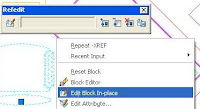 toolbar. If you don't dock it, it will close as soon as you finish this command, so dock it if you're going to edit more than one block.
toolbar. If you don't dock it, it will close as soon as you finish this command, so dock it if you're going to edit more than one block.In this screen capture on the right I've got both ways showing.


Once you've changed the block the way you want, click the 'save changes' button, the one on the right side of the toolbar. If you've lost the toolbar don't panic! Just type in REFCLOSE and you'll have the option of saving your changes.
But in AutoCAD LT, there is no REFEDIT command. So a way around this is to use the same editor that was designed to create Dynamic Blocks. Select your block and then click the Block Editor Button, it looks like a lightning bolt. It's on the standard toolbar and also on the Tools Menu Pulldown (I circled it in the picture below). In that editor you can simply change the block, you're not obligated to add dynamic features to it.
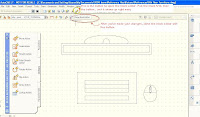
In Drawing B, in LT, I opened the computer block in the Dynamic Block Editor, erased the screen & drew a flat screen in its place, and changed the mouse to an oval.
When you're in the Block Editor, you don't get the fading effect as in full AutoCAD, but when you exit the block editor and save the changes, each block insertion will change. And that, after all, is the object of this exercise.
I wanted to mention that if you get blocks from sources that don't name things the way you would like them, there is an easy way to fix them. In the Format pulldown menu, the very last thing is Rename, or you can type in RENAME, or the shortcut REN. Once the command starts up you choose which type of object you want to change, (for example blocks, layers, text styles, etc.) and then choose the individual one to rename, and fill in the box.
I mention this here because I edited the chair block in Drawing A - opened with full AutoCAD - and the computer block in Drawing B - opened in LT - so I could show you the following tip. I renamed the computer block in Drawing B in order to insert it into Drawing A without redefining A's existing computer block.
Here's one more helpful tip about changing blocks in full AutoCAD. (Sorry but Express Tools are not available in LT) Say you get a drawing from
 someone that you need to use for the basis of your design, but the symbols they use are all different than your company standards. There is an Express Tool that will help you, in the Express pulldown menu > Blocks > Replace block with another block. You could insert your symbol blocks into the drawing, and then use this to instantly replace theirs with yours. In this case I copied & pasted my newly named computer block into the original drawing. Then I started the REPLACEBLOCK command.
someone that you need to use for the basis of your design, but the symbols they use are all different than your company standards. There is an Express Tool that will help you, in the Express pulldown menu > Blocks > Replace block with another block. You could insert your symbol blocks into the drawing, and then use this to instantly replace theirs with yours. In this case I copied & pasted my newly named computer block into the original drawing. Then I started the REPLACEBLOCK command. 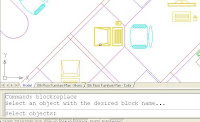
This picture is what you see as soon as you click on that 'Pick' button. I'm picking the block I want to change, the original computer block, and it will immediately bring me back to the dialog box to choose the replacement block, shown in the next illustration.
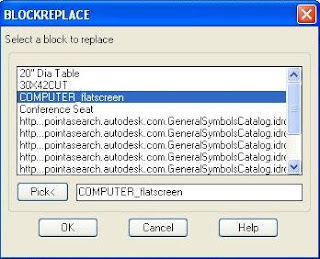
The final thing this command will ask you is if you want to purge the old block out of your drawing or not.
One thing you want to be sure of when you replace one block with another is that they're drawn at the same scale and rotation.
As the last picture shows, all the old computers with big fat monitors have been exchanged for the nice new ones with flat screens. If only it were that easy in real life!
And just to re-emphasize, due to a comment I had, this work-around using the Dynamic Block editor is not a good way to edit blocks in Full AutoCAD. For that, use REFEDIT. This is just a work-around for people who have AutoCAD LT and want to edit blocks without exploding them.
I'll be seeing some of you hopefully next week. Comm-Tech is doing a demonstration of the new features of AutoCAD 2008 and Civil 3D 2008 in Grand Junction and Vail on Friday, the 26th of October. Please tell me if you've enjoyed reading any of my blogs, it would be great to meet you!
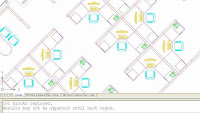





3 comments:
In the Block Editor, one also doesn't have access to background geometry for construction reference or swapping with the working set. Using the block editor is similar to modifying an external reference in its own file. REFEDIT is still more practical in top-down design.
The only problem I have is trying to use the edit block in Place command after it has been scaled up 25.4 times its normal size. How do I get around that?
Steve - You're right, REFEDIT is better for editing blocks. But as I stated above, users who have LT don't have access to that command. So the work-around is "Edit blocks in place" for LT users.
Anonymous - I can't recreate your problem. No matter what scale I insert a block at, if I use "Edit block in place", it still allows me to edit the block and the changes carry through to all the instances of that block, no matter what their scale. Could you perhaps explain further what you're trying to get it to do? Thanks!
Post a Comment